
Original Link: https://www.anandtech.com/show/1650
Intel's Pentium M Desktop Part II: ASUS' Pentium M to Pentium 4 Socket Adapter
by Anand Lal Shimpi on March 24, 2005 1:31 PM EST- Posted in
- CPUs
Before reading this article, be sure to read our first Desktop Pentium M investigation, as we will not be revisiting any of the discoveries/conclusions in that article.
At this year's Spring IDF, Derek Wilson, Johan De Gelas and I all sat across the table from Intel's Justin Rattner and asked him a question that had been on our minds ever since Prescott's introduction. The question went something like this:
Recently, Intel has shifted their focus away from ramping clock speed to increasing performance through other means such as exploiting TLP (Thread Level Parallelism). Given that Intel's direction today seems to be in sharp contrast to the direction of the NetBurst architecture and especially the direction of Prescott, were the past five years of microarchitecture improvements and innovations essentially a waste?
Rattner's exact answer encompassed a few items, but the main points were as follows:
1) At the time of Prescott's inception, clock speed is what sold, so clock speed was obviously the top priority; and they did quite well at that.
2) The past few years weren't a waste; after all, research continued in the direction of the Pentium M while all of the work on Prescott and Tejas were being done.
The second statement was particularly interesting because it was the first time that we received something tangible from Intel in regards to this question. Clearly, significant elements of future Intel desktop processors will be derived from the Pentium M architecture, but as we saw in our first desktop Pentium M investigation, the time for the Pentium M on the desktop isn't now.
As a mobile architecture, the Pentium M can't be beat. That statement alone is something many assumed that we were contradicting in our desktop Pentium M article, but the purpose of that article was to look at desktop Pentium M performance, where we determined that it fell behind. In the mobile world, without significant engineering investment, it is doubtful that the Pentium M will meet its match anytime soon.
On the desktop, we discovered that there were a handful of limitations to the Pentium M's success:
1) 855GME chipset with only a single-channel DDR333 memory controller
2) Expensive motherboards and high total cost of ownership
3) Low floating point/SSE performance
4) Severely motherboard-limited overclocking
The combination of the four items above meant a few things. While the Pentium M was an excellent contender in general use applications, its total cost of ownership was significantly higher than an Athlon 64 that performed similarly. In other applications, the Pentium M simply fell behind the competition for architectural reasons. In those cases, its high price didn't help it out at all either. The saving grace in many cases required overclocking, but the desktop Pentium M motherboards were far from overclocking monsters for those who were interested.
In the end, our stance on the Pentium M as a desktop solution was that it's more of a wait-and-see proposition. If motherboard manufacturers could produce cheaper, better equipped motherboards and if those elements improved performance, then the Pentium M would be worth another look as a desktop alternative.
We hadn't expected such a solution to come around this soon however, but it has, and not in the form that we originally thought it would. Both AOpen and DFI have indicated that they were working on updated motherboards based on the mobile 915 chipset, but that they were still months away. So when we received word that ASUS had a solution to the Pentium M desktop problem, we were caught off-guard. And rightfully so, as their solution is far from just a new chipset...
ASUS CT-479: Socket-478 to Socket-479 Adapter
Enter the ASUS CT-479 CPU Upgrade Kit, an adapter board that will convert specific ASUS Socket-478 motherboards to support Pentium M CPUs. You will remember from our original Pentium M desktop article that the pinout of the Pentium M is different than the Pentium 4, although the two chips are electrically compatible (they use the same FSB). The next problem is that the Pentium M relies on a much lower voltage version of the Pentium 4's FSB, which is also addressed by ASUS' adapter, a problem that we did not think was solvable until now.
The CT-479 only works with ASUS motherboards, and only a limited number of them at that. Currently, only the ASUS P4P800-SE and P4P800-VM motherboards are supported, both of which are i865 based motherboards. ASUS is working on support for other boards; the P4C800-E (875P) will be supported soon. For our tests, we used a P4P800-SE; you need a BIOS update, but that's all. Obviously, non-ASUS motherboards are not supported; however, we're not certain whether or not the adapter can be made to work in other boards. We will be looking into this as time goes on, but we wanted to make sure that we could complete this article first before doing anything that would damage our setup.
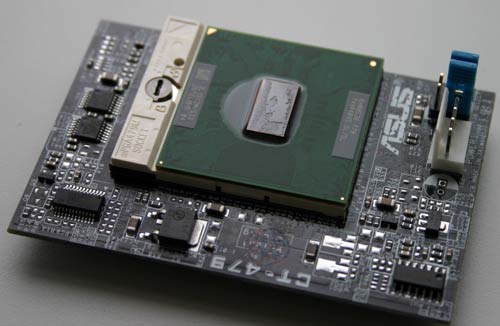
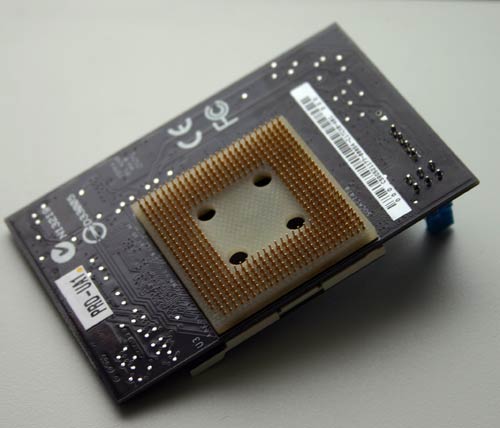
The CT-479 supports all Pentium M and Celeron M CPUs (Dothan and Banias based) with the exception of the Low Voltage and Ultra Low Voltage versions.

The jumpers switch between 400 and 533MHz FSB settings. The power connector powers the adapter.
The CT-479 comes with the adapter board, heat sink/fan and power cable.
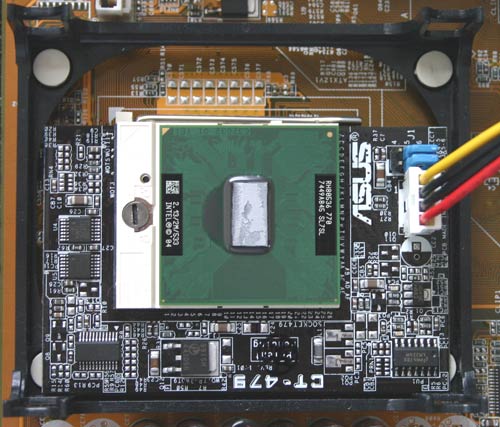
A perfect fit

The supplied heat sink is specifically made for the CT-479.
Currently, ASUS is listing the CT-479 as a part of a bundle with the P4P800-SE, priced at $130. At that price, the solution is almost half the price of the AOpen/DFI motherboards, and you get all of the benefits of the 865 chipset. The main benefit of the 865 chipset in this case is its dual channel DDR400 memory controller. The 533MHz FSB Pentium Ms are memory bandwidth starved by the 855GME's single channel DDR333 memory controller, so being paired with an 865 gives the CPU more memory bandwidth than it can use.
The P4P800-SE that we tested only allowed for 5:4 and 1:1 memory clock speed ratios, meaning that for our 533MHz FSB Pentium M, the maximum stock memory clock was DDR333. But since we're talking about a dual channel memory controller, even at DDR266 speeds, you have enough memory bandwidth for the processor - DDR400 support isn't necessary.
The other major benefit of the CT-479 is that you get to use a mature, mass-produced ASUS motherboard instead of a smaller production run, recently released 855GME solution. The benefits were clear in our testing - overclocking the Pentium M was far less of an ordeal on the ASUS solution.
The CT-479 does not support the Pentium M's SpeedStep technology, which has a handful of implications:
1) System power consumption will be higher on the ASUS solution than on 855GME based systems from AOpen/DFI. The reason being that the CPU will always run at maximum frequency, which is still lower power consumption than any other desktop processor, but it is worth mentioning.
2) You can't adjust the clock multiplier of the Pentium M like you can on the AOpen/DFI offerings. This will hamper the more adventurous overclockers, but it's definitely not a show stopper.
You also can't adjust the Pentium M's core voltage when using the CT-479; you're stuck at the default voltage. ASUS' Q-Fan technology (which allows for the automatic reduction of fan speed depending on thermal load) is supported, so you can reduce noise output even if SpeedStep isn't supported.
ASUS just announced the CT-479 last week, so there are some details that aren't yet available, such as whether or not the kit will be offered outside of the ASUS motherboard bundle. As soon as we have this information, we'll pass it along, but even if the only way to get it is with an ASUS motherboard, it is still a much better value than a standalone Pentium M motherboard.
The question here is how big of an impact does the 865 chipset have on the desktop performance of the Pentium M? To find out, we paired it with the Pentium M 770, Intel's fastest Pentium M running at 2.13GHz. The Pentium M 770 requires a 533MHz FSB, which is supported by the 865 chipset, and thus, is also supported by the CT-479 upgrade kit.
The Test
Our hardware configurations are similar to what we've used in previous comparisons.
AMD Athlon 64 Configuration
Socket-939 Athlon 64 CPUs
2 x 512MB OCZ PC3200 EL Dual Channel DIMMs 2-2-2-10
NVIDIA nForce4 Reference Motherboard
ATI Radeon X800 XT PCI Express
Intel Pentium 4 Configuration
LGA-775 Intel Pentium 4 and Extreme Edition CPUs
2 x 512MB Crucial DDR-II 533 Dual Channel DIMMs 3-3-3-12
Intel 925XE Motherboard
ATI Radeon X800 XT PCI Express
Intel Pentium M Configuration
Intel Pentium M 725 - 755
2 x 512MB OCZ PC3200 EL Dual Channel DIMMs 2-2-2-10
AOpen GMEm-LFS Motherboard
ASUS P4P800-SE + CT-479 Adapter
ATI Radeon X800 XT AGP
Business/General Use Performance
Business Winstone 2004
Business Winstone 2004 tests the following applications in various usage scenarios:- Microsoft Access 2002
- Microsoft Excel 2002
- Microsoft FrontPage 2002
- Microsoft Outlook 2002
- Microsoft PowerPoint 2002
- Microsoft Project 2002
- Microsoft Word 2002
- Norton AntiVirus Professional Edition 2003
- WinZip 8.1
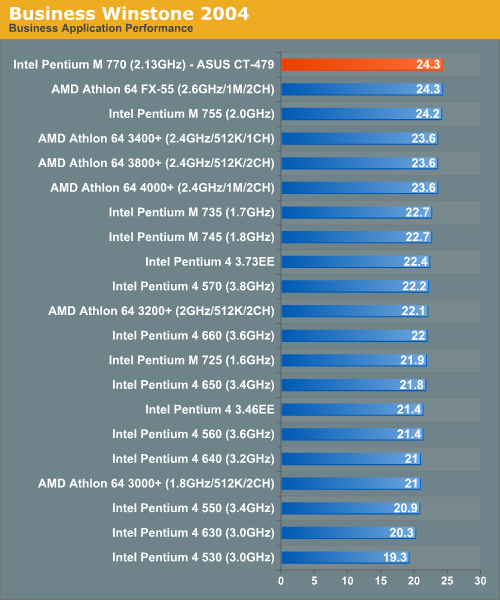
Office Productivity SYSMark 2004
SYSMark's Office Productivity suite consists of three tests, the first of which is the Communication test. The Communication test consists of the following:"The user receives an email in Outlook 2002 that contains a collection of documents in a zip file. The user reviews his email and updates his calendar while VirusScan 7.0 scans the system. The corporate web site is viewed in Internet Explorer 6.0. Finally, Internet Explorer is used to look at samples of the web pages and documents created during the scenario."

The next test is Document Creation performance:
"The user edits the document using Word 2002. He transcribes an audio file into a document using Dragon NaturallySpeaking 6. Once the document has all the necessary pieces in place, the user changes it into a portable format for easy and secure distribution using Acrobat 5.0.5. The user creates a marketing presentation in PowerPoint 2002 and adds elements to a slide show template."

The final test in our Office Productivity suite is Data Analysis, which BAPCo describes as:
"The user opens a database using Access 2002 and runs some queries. A collection of documents are archived using WinZip 8.1. The queries' results are imported into a spreadsheet using Excel 2002 and are used to generate graphical charts."
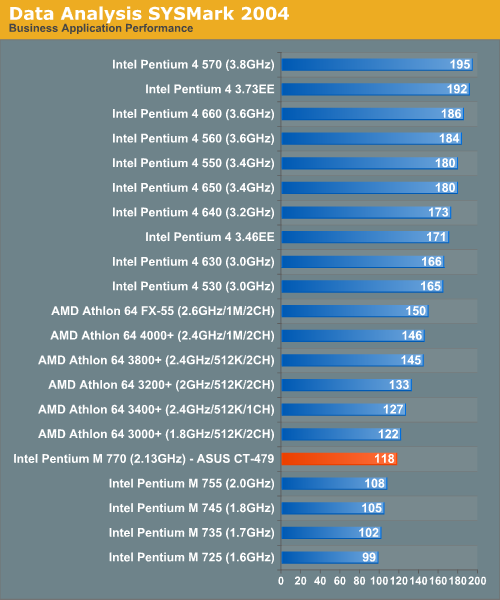
Mozilla 1.4
Quite possibly the most frequently used application on any desktop is the one that we pay the least amount of attention when it comes to performance. While a bit older than the core that is now used in Firefox, performance in Mozilla is worth looking at as many users are switching from IE to a much more capable browser on the PC - Firefox.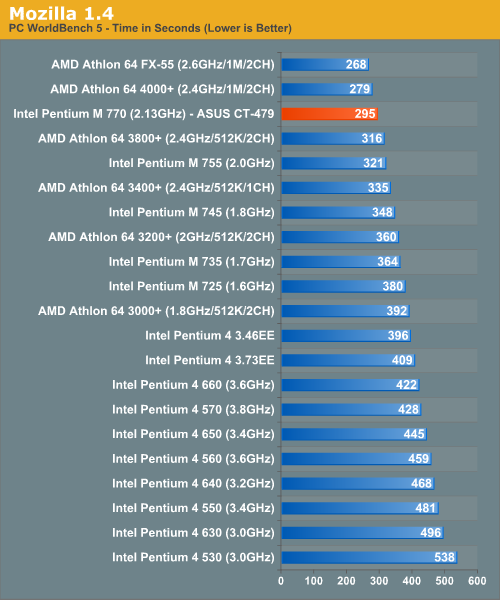
ACD Systems ACDSee PowerPack 5.0
ACDSee is a popular image editing tool that is great for basic image editing options such as batch resizing, rotating, cropping and other such features that are too elementary to justify purchasing something as powerful as Photoshop. There are no extremely complex filters here, just pure batch image processing.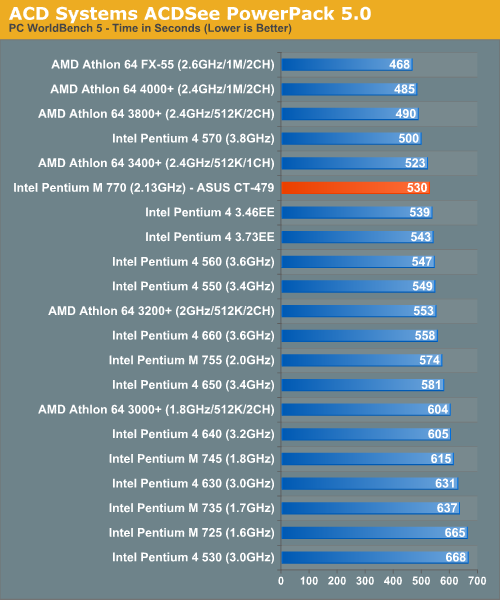
Winzip
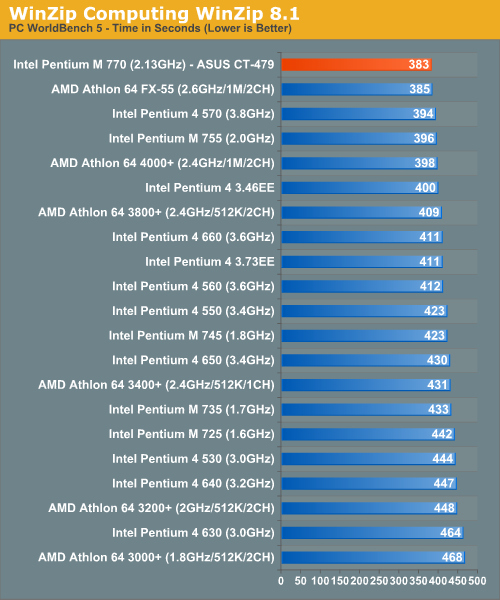
Let's look at how its peak theoretical performance is under WinRAR's built in benchmark:
WinRAR 3.40
Pulling the hard disk out of the equation, we can get a much better idea of which processors are truly best suited for file compression.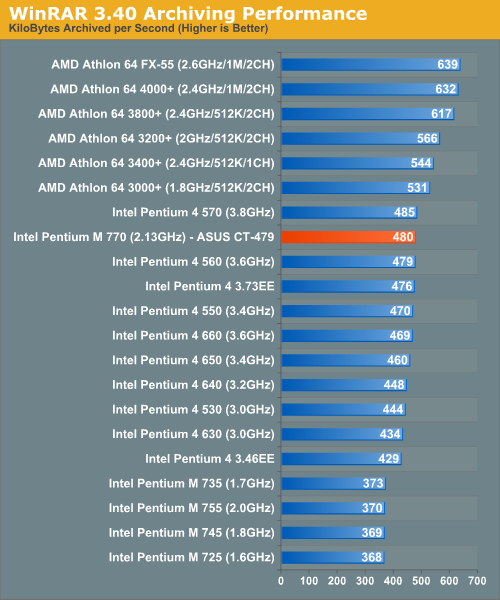
Multitasking Content Creation
MCC Winstone 2004
Multimedia Content Creation Winstone 2004 tests the following applications in various usage scenarios:- Adobe® Photoshop® 7.0.1
- Adobe® Premiere® 6.50
- Macromedia® Director MX 9.0
- Macromedia® Dreamweaver MX 6.1
- Microsoft® Windows MediaTM Encoder 9 Version 9.00.00.2980
- NewTek's LightWave® 3D 7.5b
- SteinbergTM WaveLabTM 4.0f
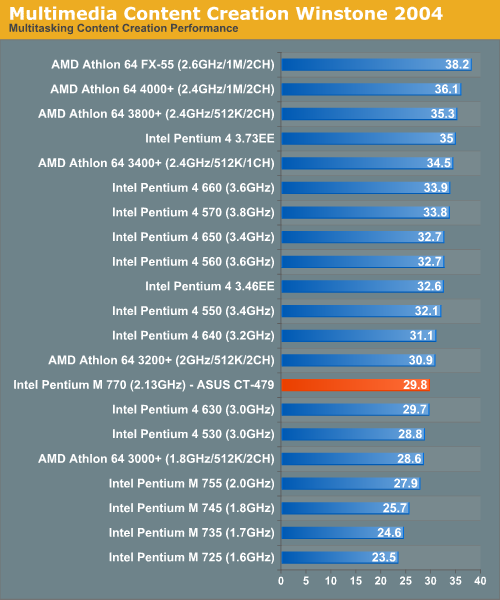
ICC SYSMark 2004
The first category that we will deal with is 3D Content Creation. The tests that make up this benchmark are described below:"The user renders a 3D model to a bitmap using 3ds max 5.1, while preparing web pages in Dreamweaver MX. Then the user renders a 3D animation in a vector graphics format."

Next, we have 2D Content Creation performance:
"The user uses Premiere 6.5 to create a movie from several raw input movie cuts and sound cuts and starts exporting it. While waiting on this operation, the user imports the rendered image into Photoshop 7.01, modifies it and saves the results. Once the movie is assembled, the user edits it and creates special effects using After Effects 5.5."

The Internet Content Creation suite is rounded up with a Web Publishing performance test:
"The user extracts content from an archive using WinZip 8.1. Meanwhile, he uses Flash MX to open the exported 3D vector graphics file. He modifies it by including other pictures and optimizes it for faster animation. The final movie with the special effects is then compressed using Windows Media Encoder 9 series in a format that can be broadcast over broadband Internet. The web site is given the final touches in Dreamweaver MX and the system is scanned by VirusScan 7.0."
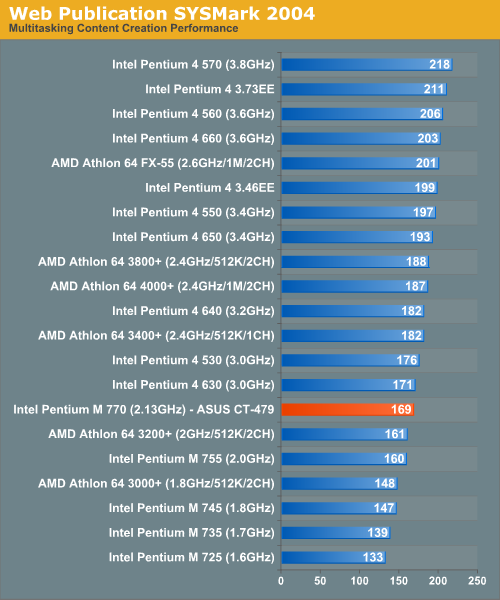
Mozilla + Media Encoder
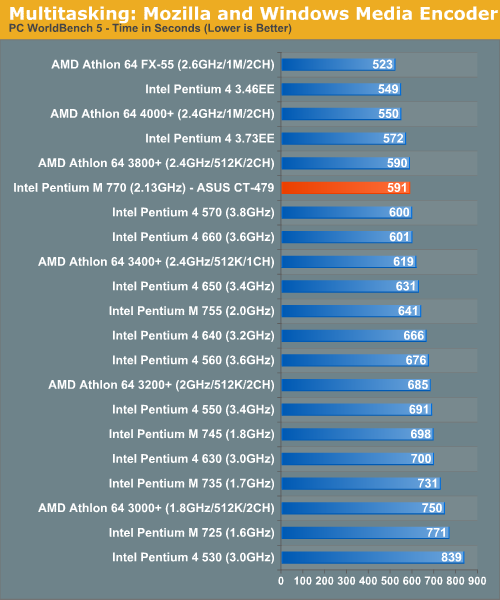
Video Creation/Photo Editing
Adobe Photoshop 7.0.1
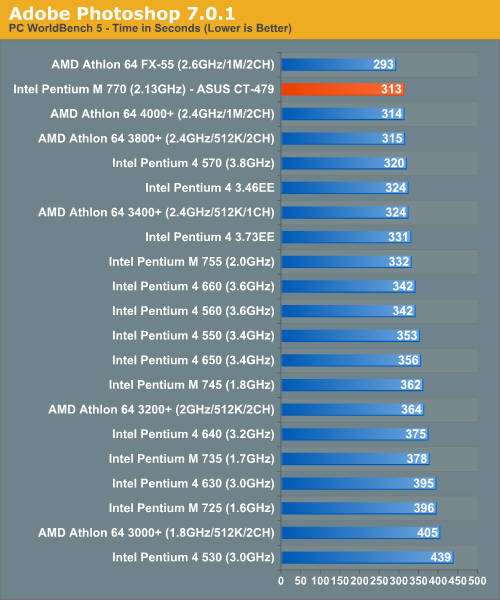
Adobe Premier 6.5
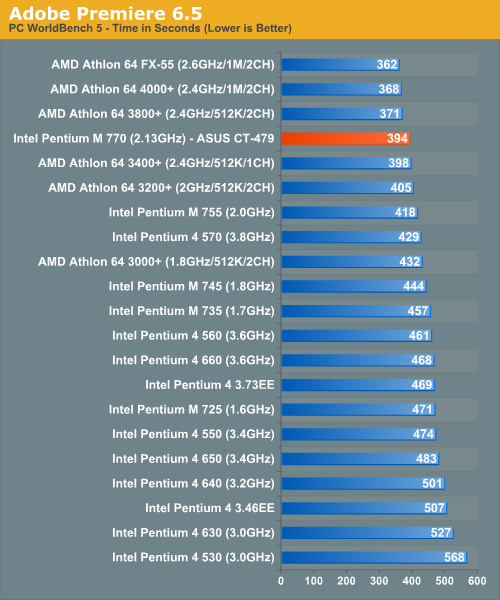
Roxio VideoWave Movie Creator 1.5
While Premier is a wonderful professional application, consumers will prefer something a little easier to use. Enter Roxio's VideoWave Movie Creator - a fairly full-featured, yet consumer level, video editing package.
Audio/Video Encoding
MusicMatch Jukebox 7.10
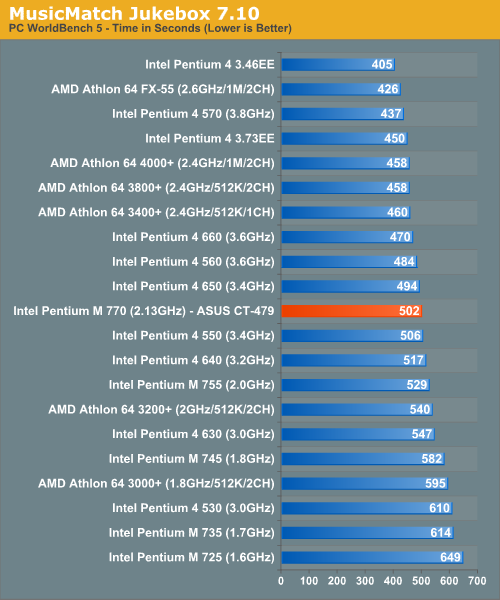
DivX 5.2.1 with AutoGK
Armed with DivX 5.2.1 and the AutoGK front end for Gordian Knot, we took all of the processors to task at encoding a chapter out of Pirates of the Caribbean. We set AutoGK to give us 75% quality of the original DVD rip and did not encode audio.
XviD 5 with AutoGK
Another very popular codec is the XviD codec, and so, we measured encoding performance using it instead of DivX for this next test. The rest of the variables remained the same as the DivX test.
Windows Media Encoder 9
To finish up our look at Video Encoding performance, we have two tests both involving Windows Media Encoder 9. The first test is WorldBench 5's WMV9 encoding test.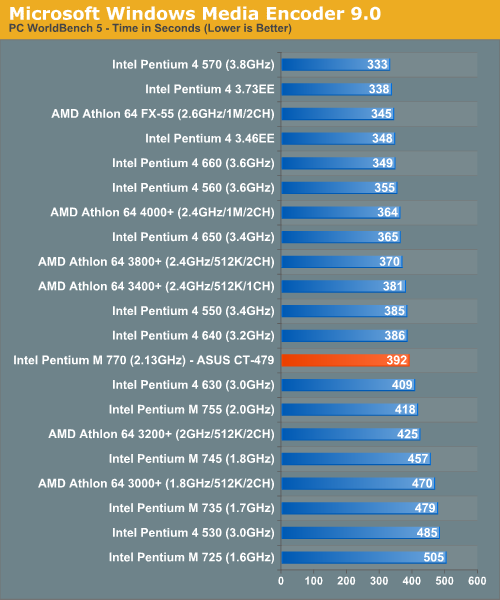

Gaming Performance
The Pentium M was a reasonably strong gaming performer, but when paired with the 865 chipset, the Pentium M becomes a high-end performer. While not as fast as the highest end Athlon 64s, it comes very close.Doom 3
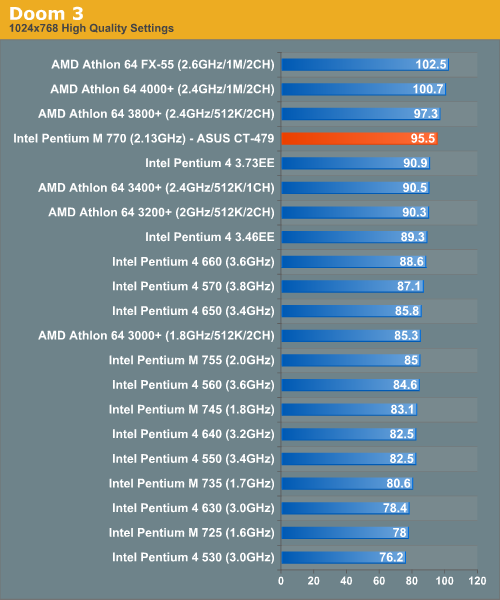
Wolfenstein: ET
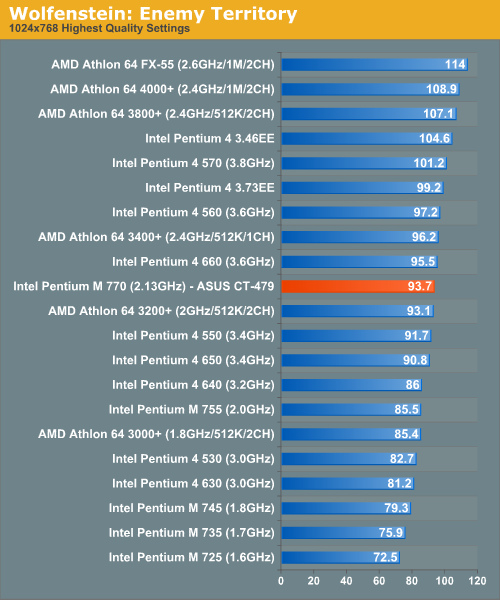
3D Rendering
3dsmax 5.1
WorldBench includes two 3dsmax benchmarks using version 5.1 of the popular 3D rendering and animation package: a DirectX and an OpenGL benchmark.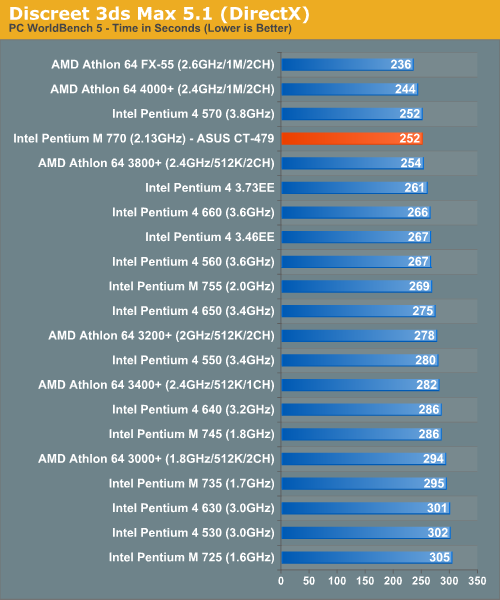
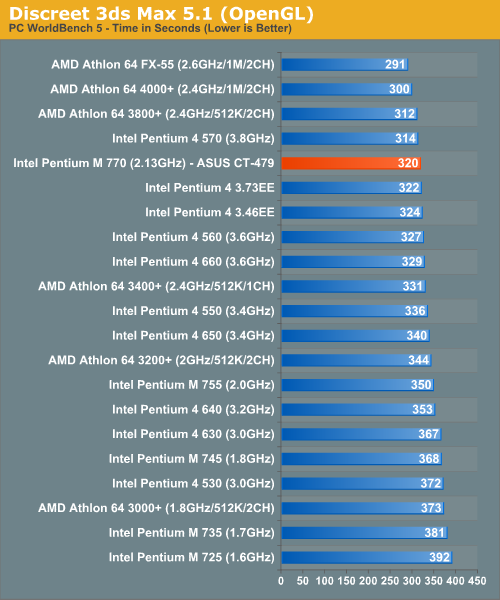
Workstation Applications
Visual Studio 6
Carried over from our previous CPU reviews, we continue to use Visual Studio 6 for a quick compile test. We are still using the Quake 3 source code as our test and measure compile time in seconds.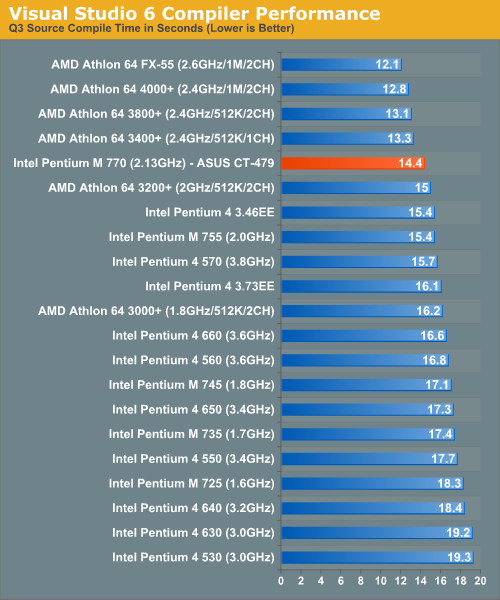
SPECviewperf 8
For our next set of professional application benchmarks, we turn to SPECviewperf 8. SPECviewperf is a collection of application traces taken from some of the most popular professional applications, and compiled together in a single set of benchmarks used to estimate performance in the various applications that the benchmark is used to model. With version 8, SPEC has significantly improved the quality of the benchmark, making it even more of a real world indicator of performance.We have included SPEC's official description of each one of the 8 tests in the suite.
The Pentium M doesn't excel in any of the SPECviewperf tests, but its performance is much more respectable with the ASUS solution, thanks to a more balanced memory bandwidth system.
3dsmax Viewset (3dsmax-03)
"The 3dsmax-03 viewset was created from traces of the graphics workload generated by 3ds max 3.1. To ensure a common comparison point, the OpenGL plug-in driver from Discreet was used during tracing.
The models for this viewset came from the SPECapc 3ds max 3.1 benchmark. Each model was measured with two different lighting models to reflect a range of potential 3ds max users. The high-complexity model uses five to seven positional lights as defined by the SPECapc benchmark and reflects how a high-end user would work with 3ds max. The medium-complexity lighting models use two positional lights, a more common lighting environment.
The viewset is based on a trace of the running application and includes all the state changes found during normal 3ds max operation. Immediate-mode OpenGL calls are used to transfer data to the graphics subsystem."
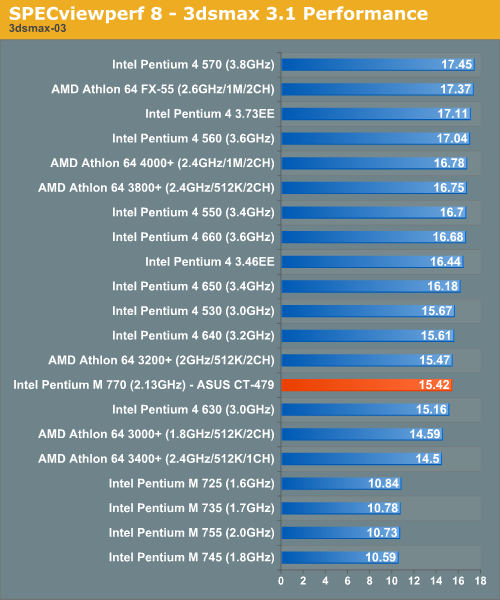
CATIA Viewset (catia-01)
"The catia-01 viewset was created from traces of the graphics workload generated by the CATIATM V5R12 application from Dassault Systems.
Three models are measured using various modes in CATIA. Phil Harris of LionHeart Solutions, developer of CATBench2003, supplied SPEC/GPC with the models used to measure the CATIA application. The models are courtesy of CATBench2003 and CATIA Community.
The car model contains more than two million points. SPECviewperf replicates the geometry represented by the smaller engine block and submarine models to increase complexity and decrease frame rates. After replication, these models contain 1.2 million vertices (engine block) and 1.8 million vertices (submarine).
State changes as made by the application are included throughout the rendering of the model, including matrix, material, light and line-stipple changes. All state changes are derived from a trace of the running application. The state changes put considerably more stress on graphics subsystems than the simple geometry dumps found in older SPECviewperf viewsets.
Mirroring the application, draw arrays are used for some tests and immediate mode used for others."
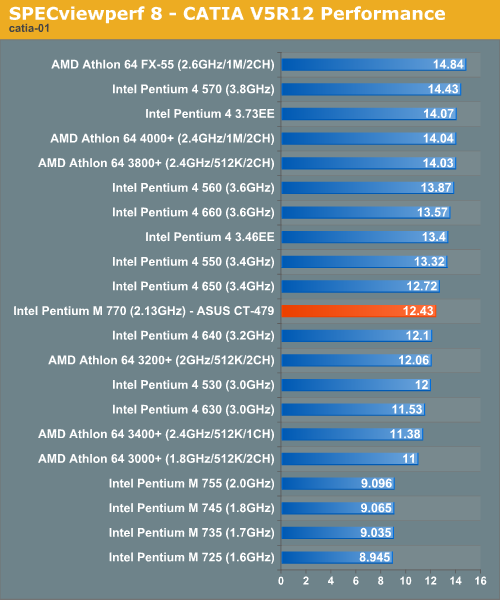
Lightscape Viewset (light-07)
"The light-07 viewset was created from traces of the graphics workload generated by the Lightscape Visualization System from Discreet Logic. Lightscape combines proprietary radiosity algorithms with a physically based lighting interface.
The most significant feature of Lightscape is its ability to simulate global illumination effects accurately by precalculating the diffuse energy distribution in an environment and storing the lighting distribution as part of the 3D model. The resulting lighting "mesh" can then be rapidly displayed."
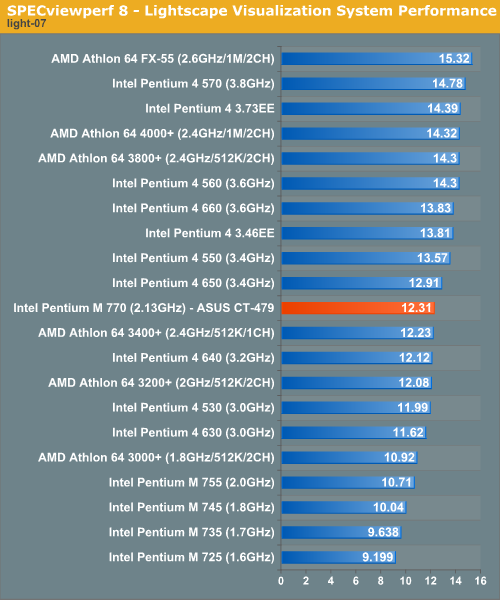
Maya Viewset (maya-01)
"The maya-01 viewset was created from traces of the graphics workload generated by the Maya V5 application from Alias.
The models used in the tests were contributed by artists at NVIDIA. Various modes in the Maya application are measured.
State changes as made by the application are included throughout the rendering of the model, including matrix, material, light and line-stipple changes. All state changes are derived from a trace of the running application. The state changes put considerably more stress on graphics subsystems than the simple geometry dumps found in older viewsets.
As in the Maya V5 application, array element is used to transfer data through the OpenGL API."
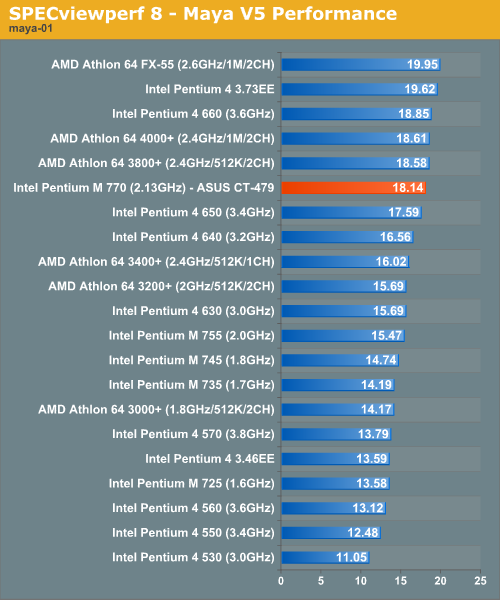
Pro/ENGINEER (proe-03)
"The proe-03 viewset was created from traces of the graphics workload generated by the Pro/ENGINEER 2001TM application from PTC.
Two models and three rendering modes are measured during the test. PTC contributed the models to SPEC for use in measurement of the Pro/ENGINEER application. The first of the models, the PTC World Car, represents a large-model workload composed of 3.9 to 5.9 million vertices. This model is measured in shaded, hidden-line removal, and wireframe modes. The wireframe workloads are measured both in normal and antialiased mode. The second model is a copier. It is a medium-sized model made up of 485,000 to 1.6 million vertices. Shaded and hidden-line-removal modes were measured for this model.
This viewset includes state changes as made by the application throughout the rendering of the model, including matrix, material, light and line-stipple changes. The PTC World Car shaded frames include more than 100MB of state and vertex information per frame. All state changes are derived from a trace of the running application. The state changes put considerably more stress on graphics subsystems than the simple geometry dumps found in older viewsets.
Mirroring the application, draw arrays are used for the shaded tests and immediate mode is used for the wireframe. The gradient background used by the Pro/E application is also included to better model the application workload."
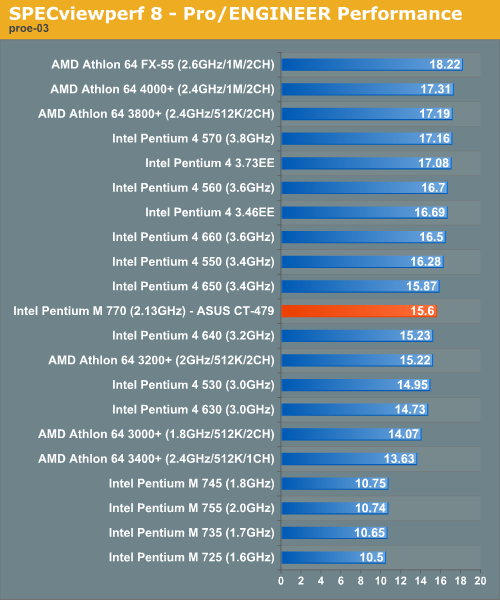
SolidWorks Viewset (sw-01)
"The sw-01 viewset was created from traces of the graphics workload generated by the Solidworks 2004 application from Dassault Systemes.
The model and workloads used were contributed by Solidworks as part of the SPECapc for SolidWorks 2004 benchmark.
State changes as made by the application are included throughout the rendering of the model, including matrix, material, light and line-stipple changes. All state changes are derived from a trace of the running application. The state changes put considerably more stress on graphics subsystems than the simple geometry dumps found in older viewsets.
Mirroring the application, draw arrays are used for some tests and immediate mode used for others."
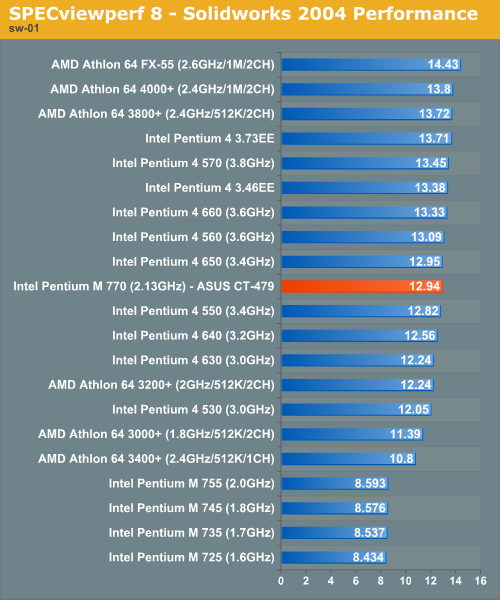
Unigraphics (ugs-04)
"The ugs-04 viewset was created from traces of the graphics workload generated by Unigraphics V17.
The engine model used was taken from the SPECapc for Unigraphics V17 application benchmark. Three rendering modes are measured: shaded, shaded with transparency, and wireframe. The wireframe workloads are measured both in normal and anti-alised mode. All tests are repeated twice, rotating once in the center of the screen, and then moving about the frame to measure clipping performance.
The viewset is based on a trace of the running application and includes all the state changes found during normal Unigraphics operation. As with the application, OpenGL display lists are used to transfer data to the graphics subsystem. Thousands of display lists of varying sizes go into generating each frame of the model.
To increase model size and complexity, SPECviewperf 8.0 replicates the model two times more than the previous ugs-03 test."
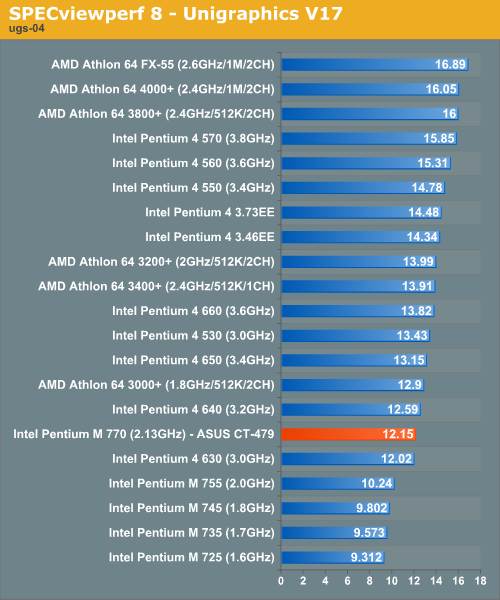
Overclocked Performance
Thus far, the Pentium M's performance is improved in some areas, but still remains weak overall in multimedia content creation applications, workstation apps, and media encoding. The ASUS CT-479 adapter allows the Pentium M to have more memory bandwidth than it needs, so if removing that bottleneck doesn't send the Pentium M to the top of the charts, then there's only one solution to improve its performance - overclocking.
Overclocking on the ASUS P4P800-SE with the CT-479 adapter is a much more positive experience than on any of the 855GME motherboards simply because the platform is far more stable when overclocked. But remember, you can't adjust the CPU core voltage or multiplier, so your only overclocking options are through increasing the FSB.
The Pentium M 770 has a 16.0x default clock multiplier running at a 133MHz FSB; we bumped the FSB up to 160MHz and took the CPU up to 2.56GHz. The memory speed stayed at a 5:4 ratio, which put our memory bus running at DDR400 speeds. Everything else remained the same, so let's look at how performance improved.
Overclocked Workstation Performance
With the exception of a couple of SPECviewperf tests, the Pentium M running at 2.56GHz ends up being a pretty formidable contender in our workstation tests:
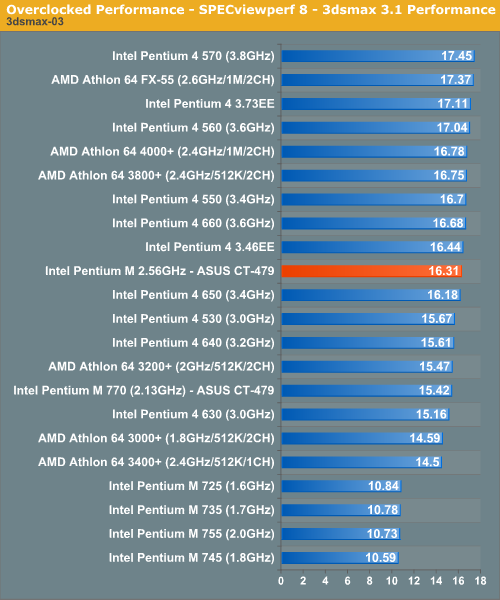
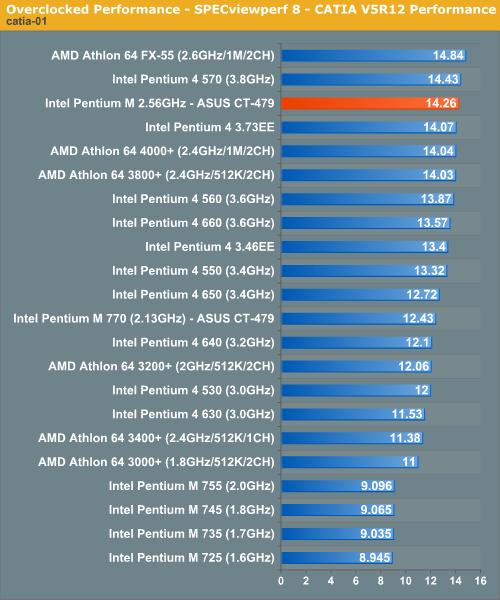
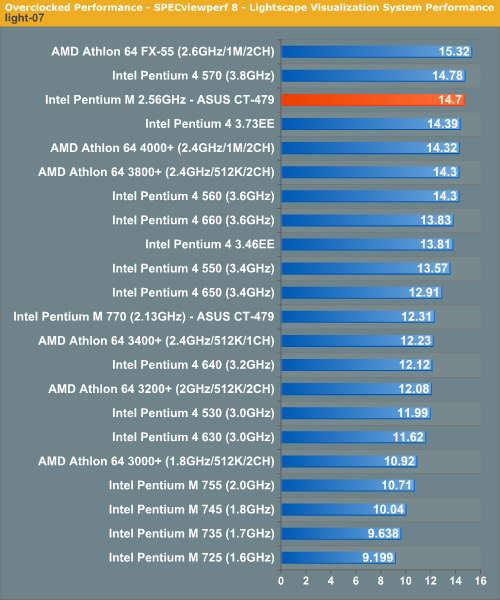
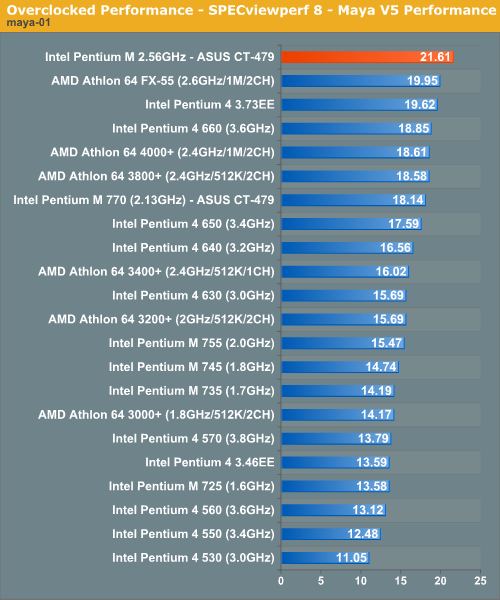
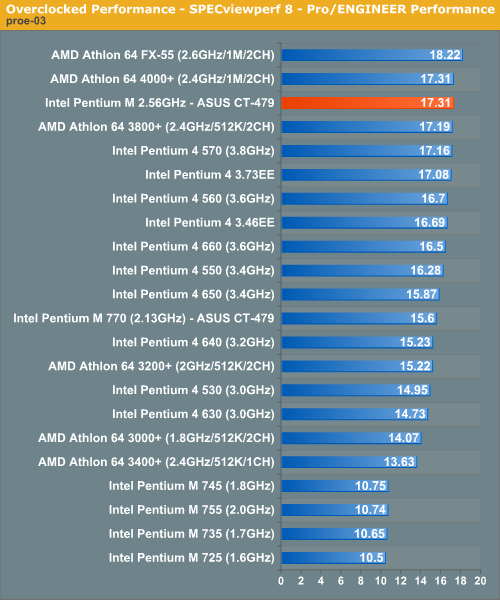
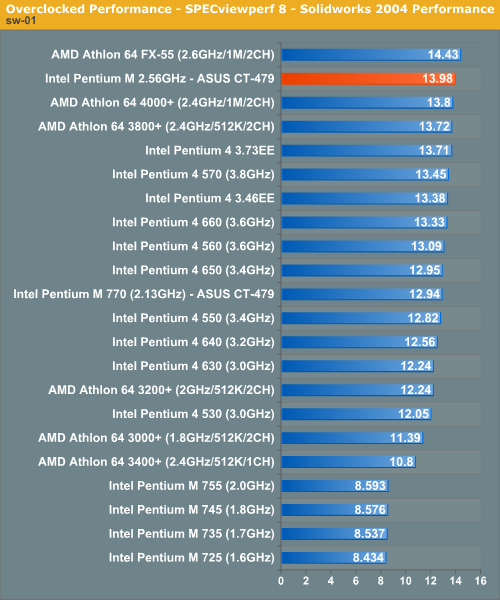
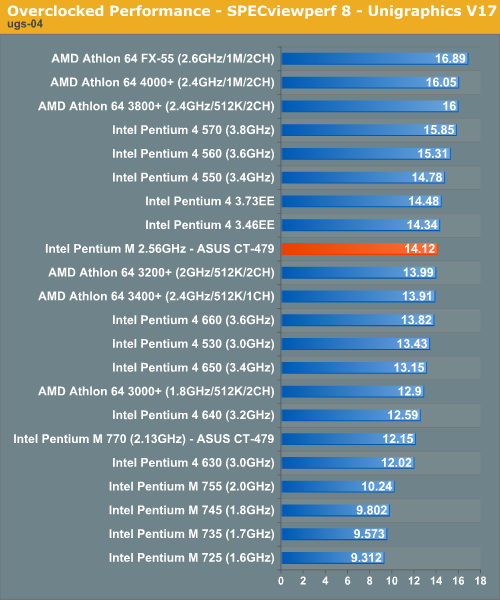
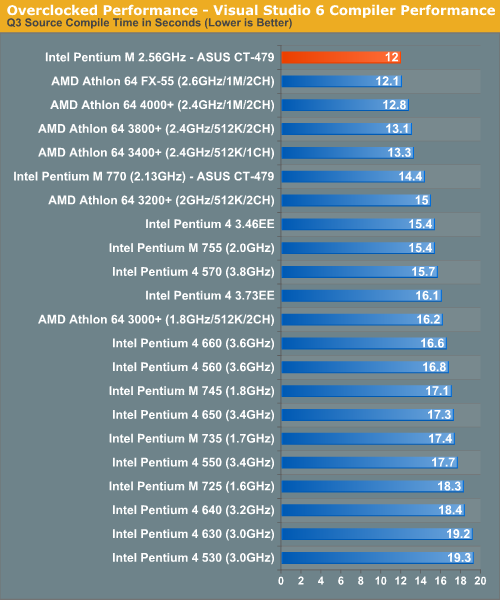
Overclocked Media Encoding Performance
Media encoding performance improved a bit, but the Pentium M still can't compete with the higher end Athlon 64 and Pentium 4 offerings:
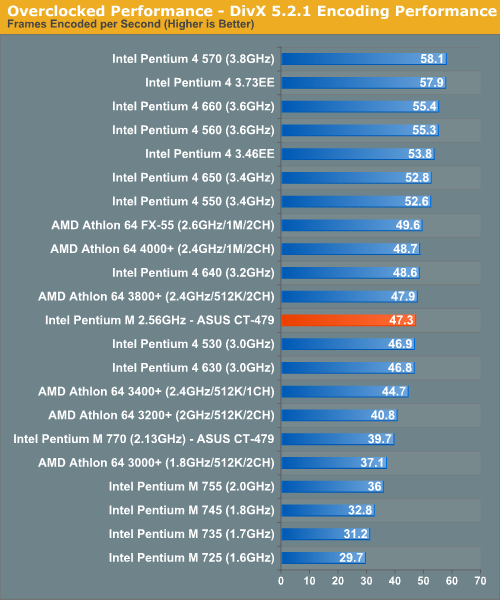

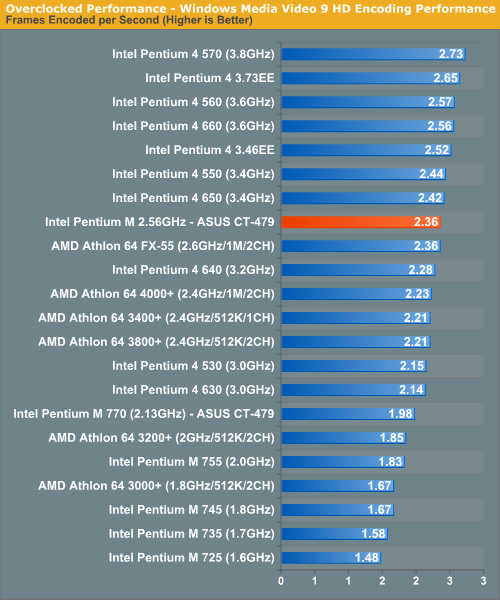
Overclocked Game Performance
Overclocking made the Pentium M an even stronger gaming platform.
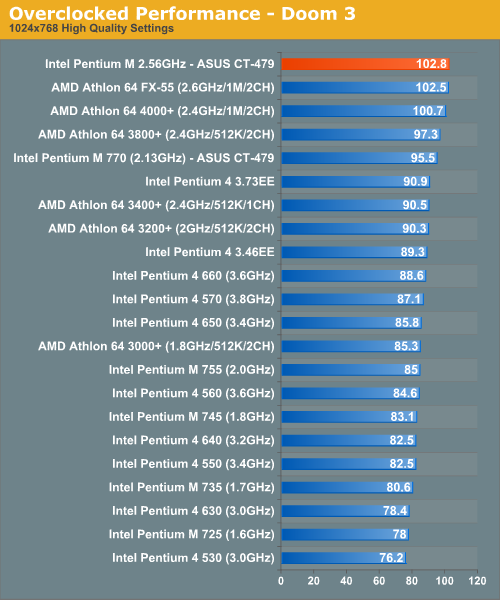
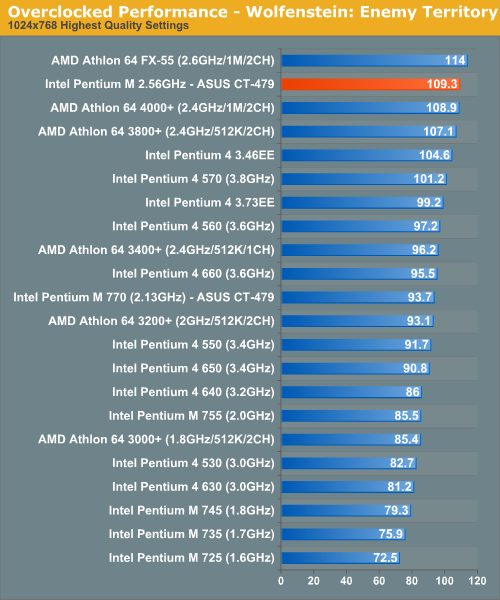
Overclocked Archiving Performance
Interestingly enough, WinRAR performance didn't go up by that much despite the overclock. It looks like we're running into architectural bottlenecks here more than anything else.
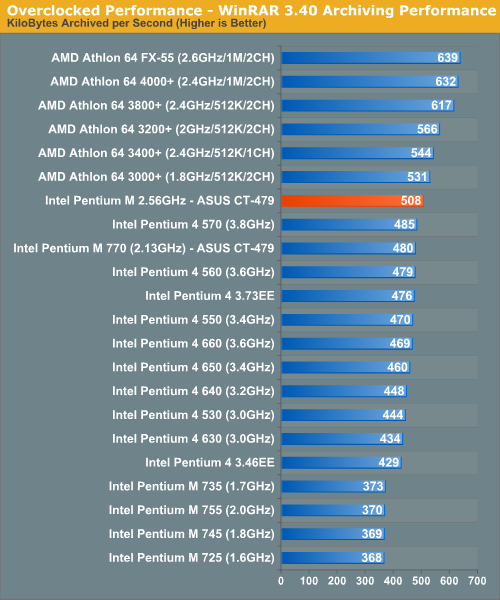
Final Words
With the CT-479, ASUS has effectively demolished all other desktop Pentium M solutions. There's no reason to even consider an 855GME motherboard from AOpen or DFI; the ASUS solution is cheaper, better performing and is even a much more stable overclocker. Kudos to ASUS for a job extremely well done with the CT-479. It's the only option that we'd recommend for those interested in a desktop Pentium M system.
That being said, despite being paired with enough memory bandwidth, the Pentium M continues to fall behind in desktop performance. As a gaming platform and as a general purpose/office machine, the Pentium M does fairly well, but it is in content creation, workstation and media encoding applications that the Pentium M continues to fall behind. Part of the problem is that the Pentium M needs clock speed to compete, which we saw when we overclocked it up to 2.56GHz. But even at 2.56GHz, the Pentium M wasn't a competitive CPU when it came to tasks like media encoding, indicating that if the Pentium M is to succeed on the desktop, it's going to need some architectural improvements.
At this year's Spring IDF, Mooley Eden (head of the design team who brought us the original Pentium M) diagramed the architectural features that would be improved in the next version of the Pentium M (code-named Yonah). All of the architectural improvements, outside of the move to dual core, involved SSE and floating point performance - the two major weak points of the Pentium M's present day desktop performance.
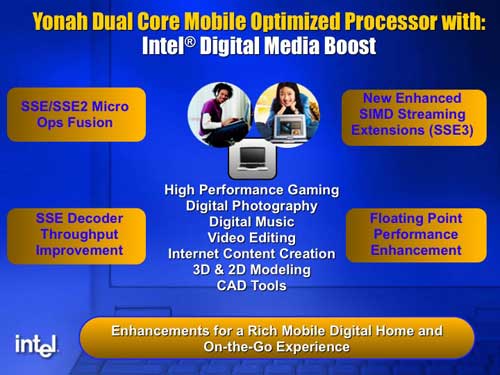
It would appear that Intel is doing their best to make the Pentium M even more desktop friendly in Yonah. While ASUS has done the best that they can to give the Pentium M a hospitable desktop environment today, we may have to wait until Yonah for it to make a lot of sense on the desktop.







